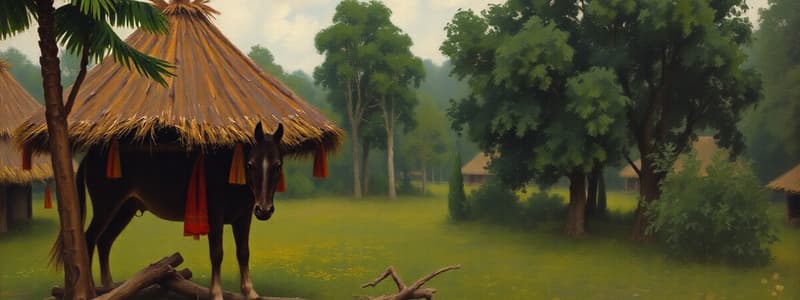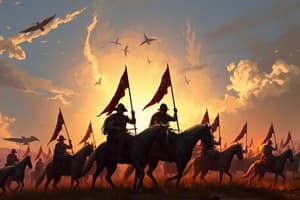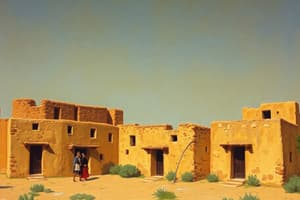Podcast
Questions and Answers
What was the primary purpose of the Chaco Roads?
What was the primary purpose of the Chaco Roads?
- They were mainly for transportation of agriculture.
- They were used solely for trade.
- They served economic and religious purposes. (correct)
- They were exclusively for military movement.
Great houses had poorer diets and higher child mortality compared to small houses.
Great houses had poorer diets and higher child mortality compared to small houses.
False (B)
What happened to Chaco society following the 1090 drought?
What happened to Chaco society following the 1090 drought?
Chaco began to disintegrate and farmers abandoned the area.
The organizing principle of Chaco society was __________.
The organizing principle of Chaco society was __________.
Match the following characteristics to the respective types of houses:
Match the following characteristics to the respective types of houses:
What were the two systems that societies split into according to Stuart's explanatory model?
What were the two systems that societies split into according to Stuart's explanatory model?
The collapse of the 'Kicker' is attributed to technological innovations.
The collapse of the 'Kicker' is attributed to technological innovations.
What factors can lead to the decline of power according to the model discussed?
What factors can lead to the decline of power according to the model discussed?
The primary focus of _______ is on sustainable resource management.
The primary focus of _______ is on sustainable resource management.
Match the following periods with their characteristics:
Match the following periods with their characteristics:
Which of the following statements best reflects the lessons learned from the Chaco experience?
Which of the following statements best reflects the lessons learned from the Chaco experience?
In the Pueblo II period, small agricultural settlements spread widely while larger farms emerged.
In the Pueblo II period, small agricultural settlements spread widely while larger farms emerged.
What agricultural products were primarily integrated into the diet by 500 BC?
What agricultural products were primarily integrated into the diet by 500 BC?
Flashcards
Power System
Power System
A social system focused on control, influence, and the ability to direct actions and resources.
Efficiency System
Efficiency System
A system prioritizing resource use to maximize output with minimal waste.
Chaco Phenomenon
Chaco Phenomenon
A period (1020-1130 AD) characterized by extensive great house construction in Chaco Canyon and surrounding areas.
Kiva
Kiva
Signup and view all the flashcards
Pueblo II
Pueblo II
Signup and view all the flashcards
Environmental Determinism
Environmental Determinism
Signup and view all the flashcards
Great Houses
Great Houses
Signup and view all the flashcards
Power/Efficiency Imbalance
Power/Efficiency Imbalance
Signup and view all the flashcards
Chaco Roads
Chaco Roads
Signup and view all the flashcards
Pueblo Bonito
Pueblo Bonito
Signup and view all the flashcards
Social Inequality at Chaco
Social Inequality at Chaco
Signup and view all the flashcards
Chaco's Disintegration
Chaco's Disintegration
Signup and view all the flashcards
Chaco's Religion
Chaco's Religion
Signup and view all the flashcards
Study Notes
Stuart's Explanatory Model
- Societies are divided into "power" and "efficiency" systems.
- Chaco culture demonstrates an experiment in power politics and rapid economic growth.
- Chaco's collapse is linked to an imbalance between power and efficiency.
- The "Kicker": Collapse was primarily caused by climate change (environmental determinism).
- Lessons: Imbalance between power and efficiency creates sustainability risks.
Power
- Control & Influence: Ability to direct actions and mobilize resources.
- Elites: Leaders who control essential activities like trade, labor, and rituals.
- Maintaining power: Requires constant effort (coercion or rewards).
- Power risks decline if resources deplete or loyalty wanes.
Efficiency
- Resource Use: Maximizing output with minimal waste.
- Environmental Fit: Adapting farming, water use, labor to local conditions.
- Fragility: Systems break down when demands exceed limits or conditions change.
Key Differences
- Power focuses on social control.
- Efficiency focuses on sustainable resource management.
- Trade-off: Power demands can reduce efficiency.
Role of Agriculture
- 2000 BC: Corn arrived in the region (from Mexico), associated with increased precipitation.
- 500 BC: Beans, corn, and squash replaced the hunter-gatherer diet.
- AD 1: Increased rainfall led to the development of pithouse communities (3-5 houses).
Early Basketmaker (AD 1-400)
- Small pithouse villages situated in areas suitable for farming.
- Reliance on hunting and gathering; villages not permanent.
Late Basketmaker (AD 400-750)
- Larger pithouse villages (10-20 pithouses).
- Kiva: Circular pithouse with a bench and foot drum, a social hub.
- Key needs included space for hunters and time for farmers to plant, harvest, and store supplies.
Pueblo I (AD 700-900)
- Villages grew larger with above-ground storage and early pueblos.
- Long-distance trade created shared risks among communities.
Pueblo II (AD 800-1000)
- Small agricultural settlements spread widely.
- Earliest great houses were large, arc-shaped with storage rooms.
- Power dynamics emerged during this period.
- Great house construction expanded across Chaco and outlying areas.
Chaco Phenomenon (1020-1130)
- Construction of multi-storied buildings with oversized kivas and T-shaped doors.
- Communities were linked through trade, reciprocity, and ritual.
- Pueblo Bonito: A large complex with 33 kivas and 700 rooms, covering 5 acres- it was the largest U.S. residence until the 1880s.
- Elites controlled the majority of surplus production.
- Chaco Roads: 12-30 ft wide with berms and stair-cases, served for economic and religious purposes, converged on Chaco Canyon.
Social Inequality
- Small houses: Severe dental problems, spinal issues, and high infant mortality occurred due to poor diets and arduous labor.
- Great houses: Taller people with lower infant mortality, better diets, and more access to game.
- Rich burials: Included luxury items.
Religion & Disintegration
- Religion was the organizing principle of Chaco society.
- Open society, no fortifications.
- Population growth created stress (food shortages, labor migration).
- 1090 Drought: A factor in the disintegration of Chaco by the 1100s, although elites responded with construction and road building.
- Great houses were shifted to the San Juan River.
- Farmers abandoned Chaco.
- Violence (warrior burials, violent deaths).
- Fewer benefits to old strategies over time.
Studying That Suits You
Use AI to generate personalized quizzes and flashcards to suit your learning preferences.




